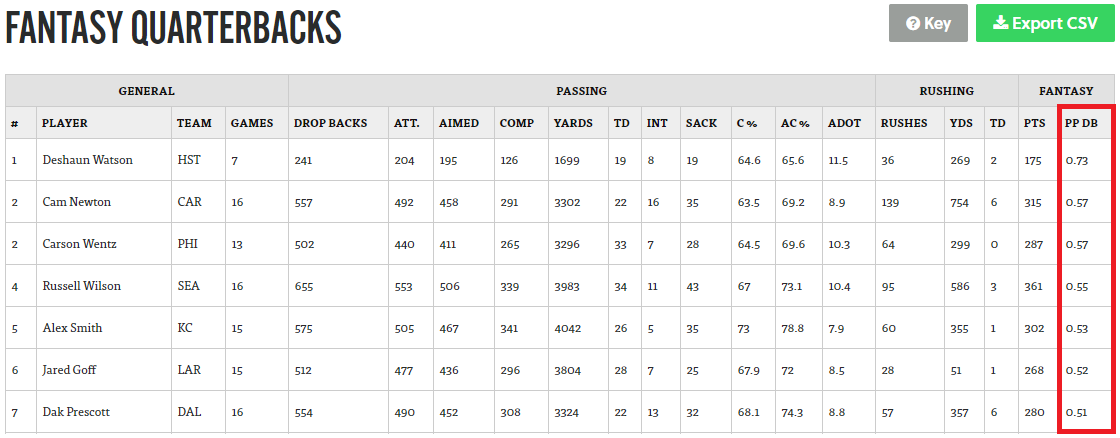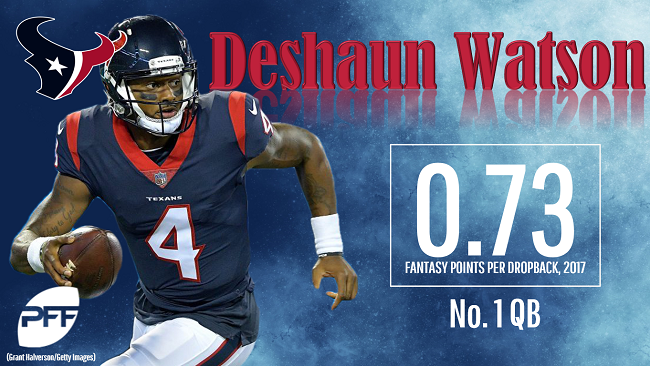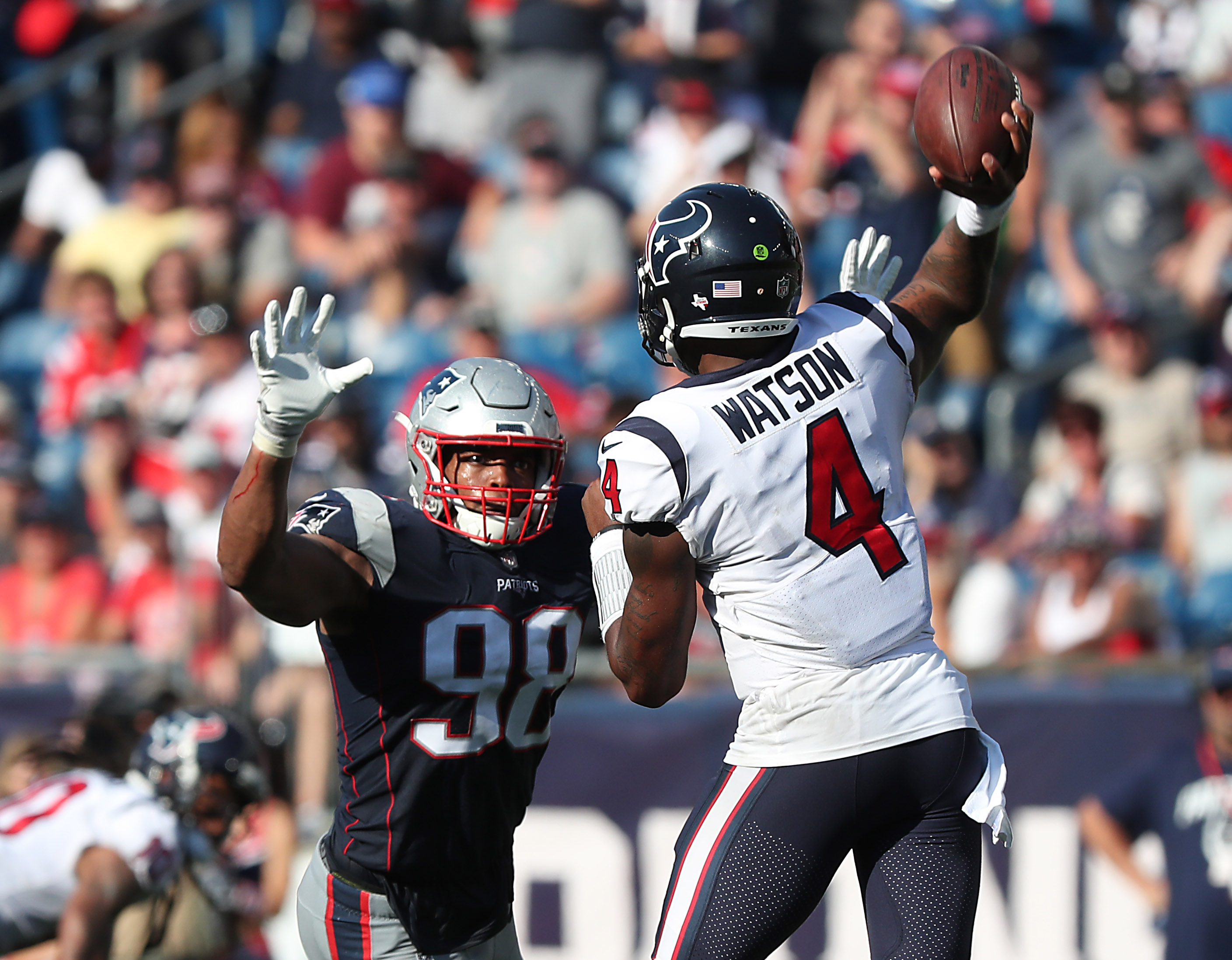(Metrics that Matter is a regular offseason feature that examines some aspect of fantasy through a microscope to dive into the finer details.)
Despite spending nearly all of my waking hours buried in NFL-related statistical research, I rarely ever have to leave our site. Between what’s available in our fantasy stats (available to Edge and Elite subscribers) and our premium stats (available to Elite subscribers), there really isn’t much else I’m ever scrambling to find.
Still, many are unaware of the potential of – or even existence of – some of these stats. One personal favorite is fantasy points per dropback for quarterbacks.
You can find this data here, but in case you’re not a subscriber, here’s a peak at last season’s top seven quarterbacks by this metric.

Fantasy points per dropback isn’t as sticky or predictive as raw fantasy points per game, but that’s to be expected considering fantasy points per game is essentially the product of fantasy points per dropback and dropbacks per game. Despite being less predictive, I do think these statistics provide additional utility from a descriptive perspective, and they will play a role in my rankings and projections.
After spending some time going back over this data, here are some of my most-notable findings and key takeaways for fantasy:

- Among all quarterbacks with at least 200 dropbacks in a single season, Deshaun Watson’s 2017 season ranks tied with 2015 Cam Newton and 2013 Nick Foles for the PFF-era (2007-2017) record in fantasy points per dropback (0.73). We already discussed Waston elsewhere – how (by a few other metrics and the small sample in general) and why Watson is likely to regress in his sophomore season. Needless to say, his current ADP ( 1 overall QB in PPR leagues) is alarming despite the historic numbers here.
- Right behind (or, rather, a good 22 percentage points behind) Watson was Carson Wentz, followed by Newton, and then Russell Wilson. Although Wilson averaged more fantasy points per game than Wentz, he also dropped back 4.2 times more per game. Wentz’s numbers weren’t a surprise to me by any means, but Newton’s certainly were, and help to highlight the importance of rushing production and efficiency from a fantasy quarterback.
Of 301 qualifying quarterbacks over the past decade, Newton’s 2017 season ranked ninth-best in rushing fantasy points per dropback, but a lowly 197th in passing fantasy points per dropback. Over the past two seasons, Newton ranks 30th of 32 qualifying quarterbacks in passer rating (78.2), ahead of only Ryan Fitzpatrick and Brock Osweiler. Newton ran the ball 8.7 times per game in 2017, thef most ever by a quarterback, and also averaged 47.1 rushing yards per game (eighth-most all-time). Newton’s passing efficiency is a major concern, but it won’t matter much if Newton continues to run at such a high rate. I further discussed the significance of rushing production for fantasy quarterbacks here. - Jared Goff (0.50) ranked behind only Wentz (0.51) in passing fantasy points per dropback, and both were fairly historic figures. Only 29 times over the past decade did a quarterback drop back at least 300 times in a season and also average at least 0.50 passing fantasy points per dropback. Goff’s fantasy totals were far less impressive, however, thanks to Los Angeles ranking 13th-lowest in offensive plays per game and second-lowest in dropbacks per game. Perhaps Sean McVay loosens the reins a bit on Goff next year with more experience in his system, leading to more dropbacks and thus fantasy points, but it seems unlikely or unnecessary after Todd Gurley’s near-MVP-winning season and their offseason overhaul on defense.
- Here’s another interesting statistic for you – over the past two seasons (min. 500 dropbacks), Dak Prescott trails behind only Aaron Rodgers in fantasy points per dropback. For perspective, Wilson averages 1.8 more fantasy points per game than Prescott over this stretch, but if Prescott averaged the same amount of dropbacks per game as Wilson, he’d average 1.9 more fantasy points per game. Like Goff, Prescott is hamstrung by volume. Dallas ranks last in dropbacks per game and pass percentage over the past two seasons. Again, like Goff, I think it’s unlikely Dallas shifts to more of a pass-heavy approach next season. Furthermore, I wonder if Prescott’s efficiency might shrink with more volume. Wilson, as a good example, averaged 33.0 dropbacks per game and 0.60 fantasy points per dropback in his first four seasons in the league. Over the past two years he averages 40.1 dropbacks per game and 0.50 fantasy points per dropback.
- Tyrod Taylor looks like a potential positive regression candidate based on his per-dropback numbers. Taylor ranks fifth-best in fantasy points per dropback (of 36 qualifying quarterbacks) over the past three seasons, but only 15th-best in fantasy points per game. Buffalo ranked third-lowest in dropbacks per game and last in pass percentage over the past three seasons, while Cleveland ranks first in dropbacks per game and second in pass percentage over this stretch. While he’s already been named the starter, Taylor does carry some draft-risk in that it’s possible a rookie quarterback might replace him at some point in the season. He might be a good late-round pick for teams who spent an earlier investment in Andrew Luck and worry about his status for the start of the year.
- Marcus Mariota is another potential regression candidate for similar reasons. He ranks eighth-best (of 36 qualifying quarterbacks) in fantasy points per dropback since entering the league but ranks just 19th in fantasy points per game. Tennessee ranks bottom-six in dropbacks per game and pass percentage over this stretch, and new head coach Mike Vrabel may opt for a quicker-paced offense or more pass-heavy approach next season (although the offensive coordinator remains the same). Mariota was already one of my top regression candidates at the position, playing well above what his passer rating would suggest and posting a touchdown rate 47.6 percent worse than his prior career average.
- Eli Manning, meanwhile, could be in trouble. The Giants rank 11th in dropbacks per game over the past two seasons, while Minnesota (head coach Pat Shurmur’s former team) ranked 22nd. This could be related in a large part to gamescript, and I don’t see gamescript changing much for the Giants in 2018, but if Shurmur opts for less of a pass-heavy approach it could put a significant dent in Manning’s numbers. Manning relied far more on volume than efficiency over the past two years, ranking top-10 in dropbacks per game but bottom-six in fantasy points per dropback. The 2.1 fewer dropbacks per game would have meant a fall from 14.0 fantasy points per game to 13.4 last year, which would have ranked sixth-worst of 29 qualifying quarterbacks.
- Matt Ryan was an obvious regression candidate (by this metric and several others) heading into 2017. Ryan averaged a league-high 0.60 fantasy points per dropback in 2016. Throughout the rest of his career, he averaged just 0.43 fantasy points per dropback. In 2017, he averaged 0.43 fantasy points per dropback. Alex Smith seems like this season’s version of Ryan, after averaging 0.53 fantasy points per dropback in 2017. His prior PFF-era average was 24 percent less, at 0.43.



 © 2025 PFF - all rights reserved.
© 2025 PFF - all rights reserved.